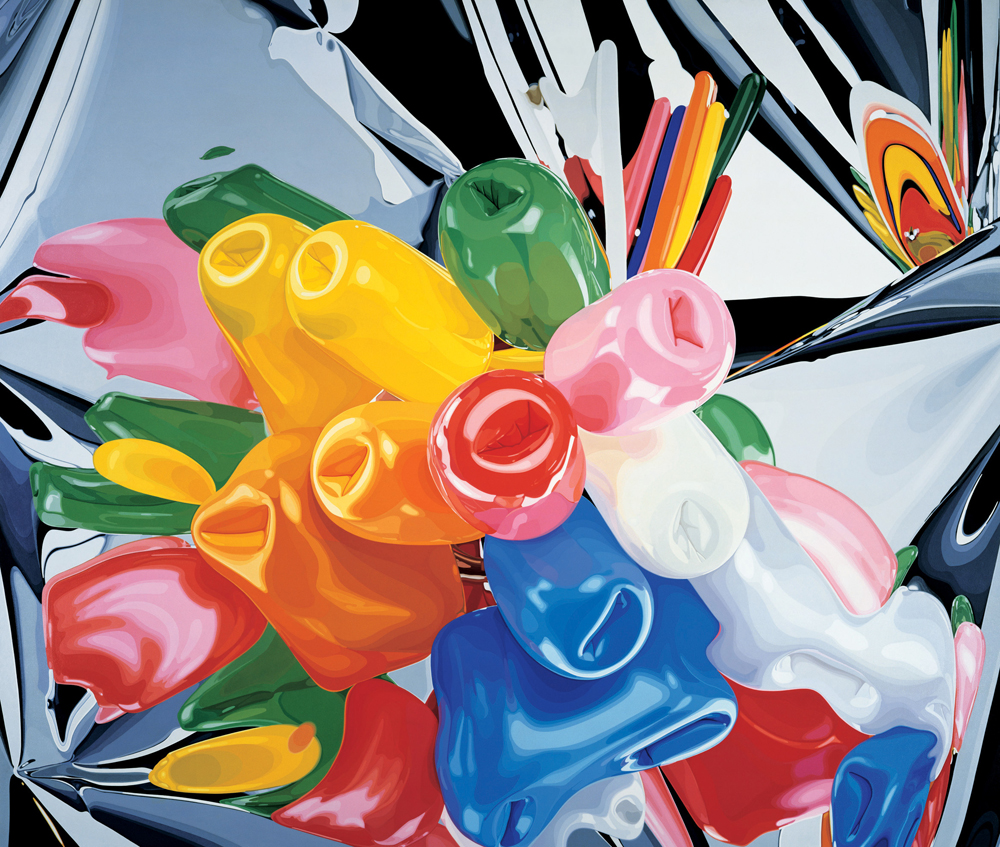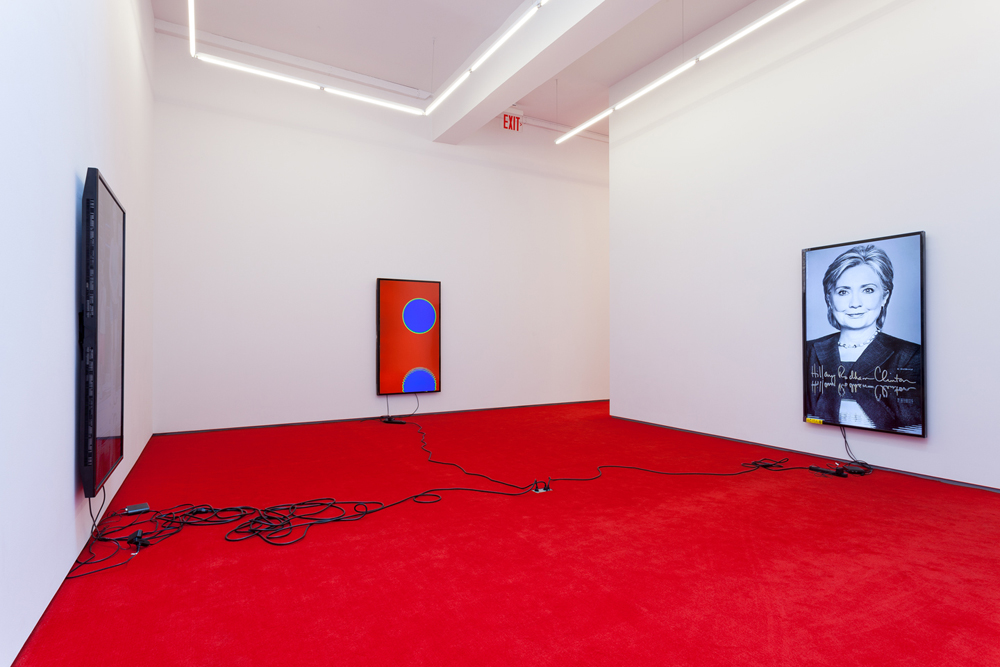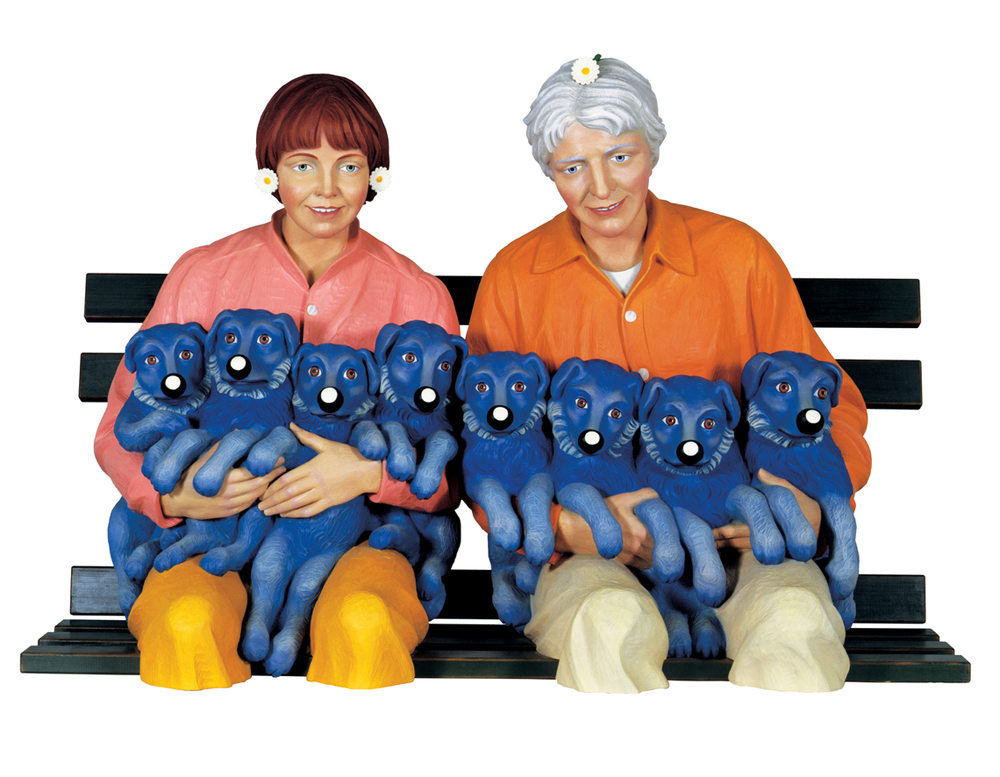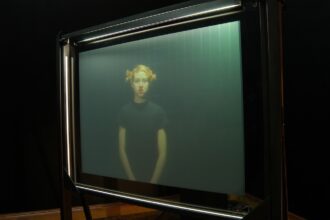If you’ve taken the New York subway in the last couple of months, you’ve probably seen advertisements for the Whitney Museum’s Jeff Koons exhibition. With Koons’s balloon dogs and other sculptural delectations framed in popping black print, the taglines read: “A retrospective as mesmerizing as his art,” or “A retrospective as audacious as his art.” Coupled with the somewhat vacuous image of a sculpture like Cat on a Clothesline, where a wide-eyed feline hangs in a green sock flanked by bright flowers, the promotions seem almost naïve. What’s audacious isn’t exactly the cat itself, but rather its promotion by a major museum. If considered internal to the savvy mechanics of institutional marketing, the posters are more like tongue-in-cheek allowances for Koons’s rabidly exorbitant spectacle. They seem to intimate, “let’s just allow ourselves to cast off the artworld’s grey-colored lenses and take in the mesmerization of Koons’s blue-chip theater.”
And that enticement has seemed to work. The Whitney has increased operating hours to account for the crowds, and widely-read critics like Peter Schjedahl and Roberta Smith have tripped over themselves to throw praise at the show. Any experience of any artwork is by definition variable, but I wager it would take a severely dampened sensorium not to join in and invite the onslaught of Koons’s sheen and shine to do its work.
Pieces like the balloon dogs or collage-oil paintings, in their uncanny illusionism and monumentalized scale, are tchotchkes in content and incredible accomplishments of artistry in form. The trickery in the difference between the referential base material (like cheap plastic or rubber) and their actual high-end counterparts (like steel or porcelain) seduces its viewers; your eyes happily follow the curvature of the gloss in its broad contours. Though it may seem like only one attribute of Koons’s work, his use of expensive materials is crucial to his effect. The transformation of ordinary to extraordinary matter exaggerates the progression of kitsch to sublimity (which, let’s remind ourselves, is not just a state of awe but of terror in the face of something awe-inspiring).
Indeed, through that dynamic of pleasure, the Whitney describes Koons’s approach as one of democracy. His exhibition invests in inviting the museum visitor to submit to what pleases him or her, whether it’s the goofy fun of his million-dollar metal lobsters or the hardcore erotics of his “Made in Heaven” series. The wall panels tell us that his famous “Banality” works are “aimed at freeing us to embrace without embarrassment our childhood affection” and that “Heaven” is an “emancipation from the shame of sex.” Koons acts as ringleader of commodity-spectacle, a carnivalesque Henry Ford techno-manufacturing genius searching far and wide for the best craftsmen and materials — all for your joyous, shameless perusal. Commodity speaks as a vernacular language in Koons, but broadcast at the Whitney for maximum volume. Koons elides any questions of taste or judgment in favor of a giddy commons: why be critical when you can be having fun?
Downtown, another artist takes on themes of pleasure, consumption, taste, and technology. A generation (or two) behind Koons, Cory Arcangel’s newest exhibition at Team Gallery (José Freire’s den for art Wunderkinder like Ryan McGinley) is titled tl;dr (or, “too long; didn’t read”) and also presents the consumer commodity as a symbol of our culture writ large. The exhibition consists of large flat-screen televisions set on their side, each displaying an image that could’ve been a screenshot from any hour of internet browsing. You see the cover of Hilary Clinton’s new book, Sean Combs on a private jet, or a stock image of polychromatic visors. In the bottom quarter of each image, Arcangel digitally applies the “lake” effect, which creates a shimmering, rippling reflection on the screen. In the material world, a plush, red carpet lines the entire floor of the gallery in an installation detail repeated from his 2013 retrospective at Montreal’s DHC gallery. The whole set-up evokes a funky rec room-cum-Best Buy AV showcase.
In both Koons and Arcangel, technology’s dramatic interaction with consumer culture becomes explicit. The pleasure lies in seeing unlikely art ascend to a level of aesthetic sophistication, as if the readymade skipped Duchamp’s cerebral wit and instead originated with Sherry Levine’s take on the urinal. For Arcangel, technology moves in humbler ways: opposite the clean presentation of commercial galleries, each monitor leads to a jumbled mass of cords and wires plugged into the gallery floor. Stickers and tape remain on generic televisions. The monitors appear just as they would in a commercial setting, albeit rotated 90-degrees and stuck on the “lake” effect. If Koons’s enormous studio-enterprise replaces the standard hand of the artist, Arcangel’s dematerialized digital touch modulates the image in an almost painterly way. His application of the lake effect, he cheekily suggests, is what turns ordinary visual culture – like an Instagram of Skrillex and Larry David cavorting – into “art.”
The border between the readymade and its inspiration, or art and its appropriated object, pinpoints the pleasure in Arcangel and Koons’s works, even if they evoke different emotional registers. One demands a gasp and the other a smirk. Like Koons, Arcangel has often sought to dislodge standard valuations of artfulness, from his YouTube cat montages set to Schoenberg, to his ingeniously modified videogame consoles. To decry the banality of both Koons and Arcangel’s exhibitions would miss the point: there’s very little that’s quotidian about Koons’s “Banality.” Even asking how something like String of Puppies – a conventionally “tasteless” work of art if there ever was one – achieves status in a major international retrospective would demand a comprehensive overview of late capitalism.
Critics and curators have consistently described both artists in terms of desire. In this line of thinking, Koons’s unrelenting emphasis on unfettered pleasure registers a sort of regressive, naïve, child-like condition, as if the world offers only good feelings. When applied to Arcangel, his interest in passé technologies and media supposedly signifies a nostalgic melancholia for a cultural techno-adolescence, a relatively facile analysis that consistently brackets the past as a long-lost site waiting to be excavated. It asserts that artists working in digital technologies constantly long for their tools of yesterday. In both cases, the feelings toward these consumer objects — innocent and originary — activates an attachment to what was lost. If we giggle or gasp at the work of Arcangel or Koons, we’re stealing a sensation of enjoyment that contemporary art, in its ostensible criticality, might disavow. The readymade is a guilty pleasure that plays on a marketplace tension between what art should and should not be, all in a bizarre parallel to personal maturation. In the context of these two artists, the readymade speaks to a longing for what we used to enjoy, now on public display.
Therein lies the political danger in thinking the commodity stands in for culture in its broadest form. Whose culture is it exactly? Arcangel’s work consistently imagines a generalized type of consumer-citizen who’s perfectly in-sync with pop culture often at the expense of politics. In a similar vein, Koons assumes a viewer of pure sensation who empathetically responds to advertisements, toys, sex, and porcelain — nice things. Mass culture equals commodity culture, an ethos that designates what critics have woefully identified in action at the Whitney. For Hyperallergic’s Thomas Michelli, the notion of a viable American art collapses into “philistinism and sentimentality” in a “surrender to the leveling forces of consumerism.” Koons, with a smile, aggressively insists on the lowest-common denominator.
Both exhibitions ask for very little from their spectators. At Team, one encounters the solemn history of anachronism. All cultural momentum freezes into technological archaeology, forever rippling at the hands of the lake algorithm. Uptown, one stumbles in and out of a surfeit of amusement, where the galleries aren’t foils to life outside the museum but intensifications of what one tries to avoid. It’s like seeking shade from a glaring sun only to find that indoors, the lights are even brighter. For Arcangel and Koons, there’s no respite from the marketplace desires of our consumptive pleasure.






























